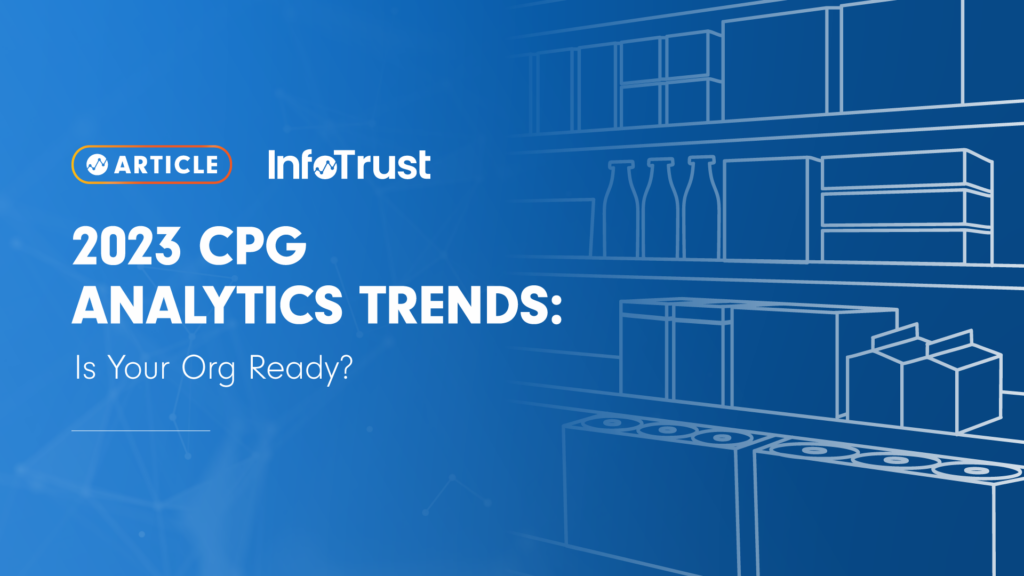What is your CPG organization doing to prepare for 2023? Each year brings several changes in the digital analytics landscape, and with that comes opportunity to evaluate your strategy. Let’s take a look at three trends that CPG organizations must be aware of in 2023.
Shopping Behavior Changes
Grocery delivery, curbside pickup, and same-day shipping have all changed how consumers interact with your products. Previously, consumers limited their online or digital shopping to clothing or tech products, but now everything from a specific type of coffee creamer to a paint color at a hardware store can be purchased online and picked up curbside. An online digital presence has been significant for quite some time, but its value is only increasing.
Google Analytics 4’s (GA4) dual-platform measurement allows for an integrated understanding of how users interact with your products on both apps and websites. As you work on your 2023 measurement strategy, ensure your app events and web events share a measurement strategy. They must be evaluated side by side.
This blurring of the line between ‘online’ and ‘offline’ brings opportunity for organizations to connect the two. Even if a consumer is physically going to the store to pick up a product, measuring the connection between your digital marketing efforts and in-store purchases is possible, even without third-party data.
Simplification / Data Minimization
While consumers’ shopping behavior becomes more complex, the best way to understand it is to simplify your tracking. For a long time, the trend in digital marketing and analytics has been to “track everything”. The idea here is that the data might be useful someday, so it’s best to capture it. This often brings more harm than good, as tracking “everything” leads to bloated, inefficient analytics programs where trust in your insights diminishes. Think of data points like items in your home—more doesn’t necessarily equal better value. It leads to clutter and time spent searching rather than time spent analyzing.
2023 brings an opportunity to consider simplifying your measurement strategy—everything from event tracking (does that button-click event tell you anything useful?) to personal data tied to users. This is especially significant for multi-market, multi-brand organizations with large sets of data. When you’re looking for cross-brand or cross-market insights, connecting data sets only gets more difficult if the volume of data is too large.
Lastly, simplified data collection is more sustainable. If (read: when) a member of your analytics team leaves and is replaced, can the new team member easily discern what is being tracked? Your analytics strategy should have these future users in mind. Focus less on the ‘quick wins’ of tracking and think toward the future. Build out your analytics program with empathy for those who will consume the data down the line. The transition to GA4 is an opportune time for this. As you’re mapping your organization’s events from Universal Analytics (UA) to GA4, consider what truly needs to be captured. It’s likely that not everything you’re capturing in UA needs to be transitioned over to GA4.
To help simplify, ask yourself ‘what decisions have we made by analyzing this data?’
A Privacy-Centric Approach
It’s no secret that privacy is a hot topic in digital marketing. Becoming privacy-focused in your digital analytics strategy in 2023 isn’t just a good idea, it’s a necessity. A privacy focus isn’t just about following the letter of the law, it’s about respecting the consumer. While the sunset of UA has been pushed back (July 2024 at the time of writing), organizations shouldn’t wait to migrate their tracking to GA4, which comes with additional privacy features, such as consent mode. This all should be done in the spirit of simplification discussed earlier. What do you really need to know about your user in order to provide a great experience?
What are your priorities for digital analytics in 2023? The best way to approach this is to start small and simple—what can you begin taking action on today? It’s a lot to consider, and we’re always here to help if you have any questions.


